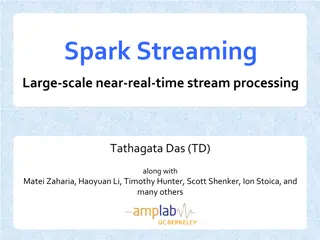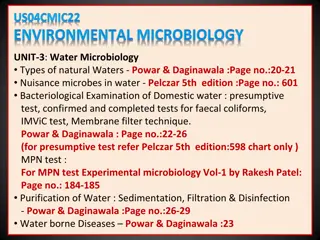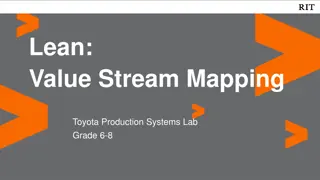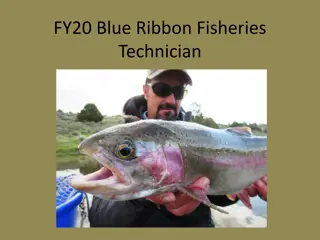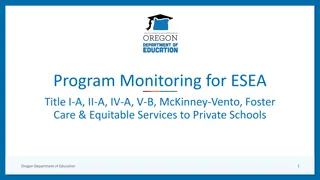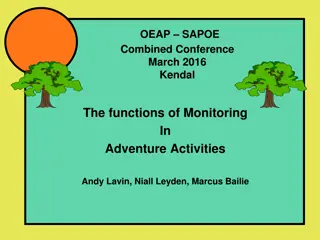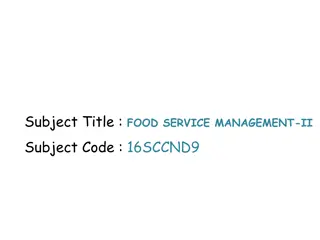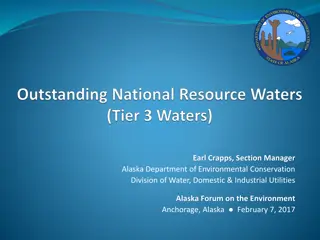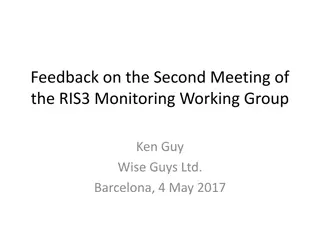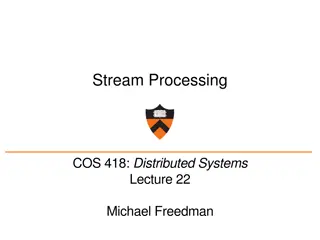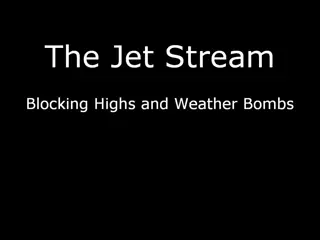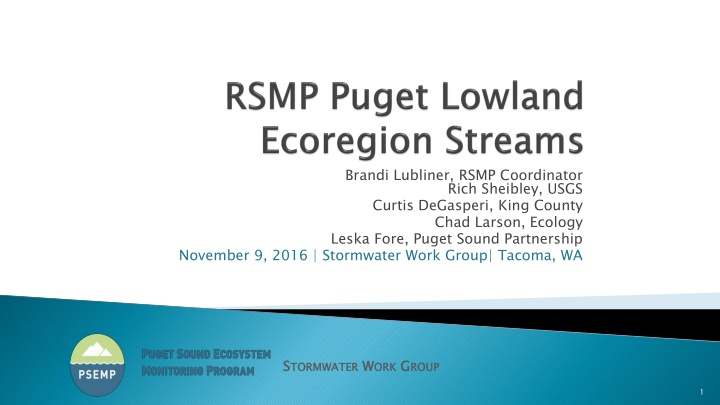
RSMP Receiving Waters and Stream Monitoring Studies
This document discusses the effectiveness studies and findings related to the RSMP program in the Puget Lowland region, focusing on water quality monitoring, watershed health assessments, and GIS analysis. It covers topics such as stream habitat, sediment chemistry, contaminants, bacteria indicators, and more. The studies aim to evaluate the health of receiving waters, analyze key resources, and assess the impact of different factors on water quality in the region.
Download Presentation

Please find below an Image/Link to download the presentation.
The content on the website is provided AS IS for your information and personal use only. It may not be sold, licensed, or shared on other websites without obtaining consent from the author. If you encounter any issues during the download, it is possible that the publisher has removed the file from their server.
You are allowed to download the files provided on this website for personal or commercial use, subject to the condition that they are used lawfully. All files are the property of their respective owners.
The content on the website is provided AS IS for your information and personal use only. It may not be sold, licensed, or shared on other websites without obtaining consent from the author.
E N D
Presentation Transcript
Brandi Lubliner, RSMP Coordinator Rich Sheibley, USGS Curtis DeGasperi, King County Chad Larson, Ecology Leska Fore, Puget Sound Partnership November 9, 2016 | Stormwater Work Group| Tacoma, WA S STORMWATER TORMWATER W WORK ORK G GROUP ROUP 1
RSMP Receiving waters: Are things getting better or worse? Are we protecting key resources? Big Questions Big Questions RSMP Effectiveness studies: What is/isn t working? What works better or more cost-effectively? Shared regional studies and findings Shared regional studies and findings 2
Puget Lowland Ecoregion Streams Site selection Summer 2014 Monitoring for monthly WQ January Dec 2015 Stream habitat and sediment Summer 2015 Marine UGA shoreline/nearshore (40 UGA sites) Contaminants filtered by mussels (WDFW led) Winter 2015 2016 Winter 2017 2018 Sediment chemistry (multi-agency team) Summer 2016 Bacteria Indicator Data (BEACH) Compilation effort 2016 3
RSMP Puget Lowland Streams (2015) Puget Lowland Streams; January Monthly water quality at 60 sites (30 Within and 30 Outside UGA) Conventional: (DO, pH, conductivity, temperature, DOC, chloride, fecal coliform, hardness, NH3, NO2+NO3, Total N, Total P, ortho P, TSS and turbidity) Metals: totals and dissolved (Ag, As, Cd, Cr, Cu, Pb, and Zn) Organics: PAHs Stage and stream discharge Summer Watershed Health Monitoring at RSMP Stream sites Once at 104 sites (was intended to be 50 Within and 50 Outside UGA) Water Quality: (DO, pH, conductivity, temperature, NH3, NO2+NO3, Total N, Total P, TSS and turbidity) Benthic macroinvertebrates: 8ft2 Physical Habitat: (full protocol which includes 251 metrics: e.g. riparian vegetation, sediment size, slope, bankfull width, LWD, discharge, etc) Periphyton: Ecology s updated protocol Stream Sediments: <2mm sieve size: Grain size, TOC, percent solids, phthalates, PAHs, PCB congeners, and 106 common residential and road use pesticides <63um sieve size: Metals (Ag, As, Cd, Cr, Cu, Pb, and Zn), and TOC Puget Lowland Streams; January December 2015 December 2015 Summer Watershed Health Monitoring at RSMP Stream sites 4
RSMP Puget Lowland Streams (2015) Watershed and Riparian GIS analysis Leveraged USGS NAWQA expertise to derive GIS parameters (~110 variables) for all RSMP sites and 16 reference sites. In-kind support from NAWQA to complete this work and provides an identical GIS dataset to the targeted NAWQA study in 2015 in Puget Sound (47 small stream sites). Watershed delineations using StreamStats (USGS Tacoma) Riparian reach digitizing and buffering (USGS CA) GIS analysis for both the watershed and riparian buffers (USGS CA) Why look at riparian and watershed land use? Proximal land use shown to be important factor for biological communities (Zelt and Munn, 2009) Riparian reach derived from watershed area (Johnson and Zelt, 2005) Watershed and Riparian GIS analysis riparian reach length = log10 (watershed drainage area) Each site had a unique riparian reach length Choose a 50 meter buffer (50 meters one each side) based on results from Zelt and Munn (2009) 5
RSMP Streams contd All Field and Chemistry Data Available in EIM RSMP_PLES is the Study ID Comparison between labs was good GIS data will become published USGS dataset Stream Data Analysis Schedule King Co, USGS, Ecology, and PSP Interim data products this Winter Draft report anticipated in March 2017 Stream Answer SWG the study design questions! All Field and Chemistry Data Available in EIM GIS data will become published USGS dataset Stream Data Analysis Schedule Stream Analysis Goals Analysis Goals 7
RSMP Streams Questions and Analysis Topic 1: Status Assessment of Puget Lowland Stream Quality Topic 1: Status Assessment of Puget Lowland Stream Quality Q1. for beneficial uses within and outside urban growth areas (UGAs)? Q1. What percent of streams meet biological, water, and sediment quality standards Q2 UGA? Q2. . What natural variables correlate with the status of streams within and outside the Q3 UGA? Q3. . What human variables correlate with the status of streams within and outside the 8
RSMP Streams Sediment/Water Chemistry Frequency of Detection 9
Detected >50% of time Detected 20-50% of time Detected <20% of time A B C Sediment Quality Sediment Quality ------------- ------------- -------------- -------------- Water Quality Water Quality Detection Frequency Outside UGA Within UGA Parameter A A A A A A A A A A B B Detection Frequency Outside UGA Within UGA C C C C C C C C C C C C C C C C C C C C C C C C C C C C C C C C C C C Detection Freqency Outside UGA Within UGA Parameter B A A A A B A A A A A A A A A A B Detection Freqency Outside UGA Within UGA C C C C C C C C C C C C C C C C C C C C C C C C C C C C C C C Parameter Arsenic Cadmium Chromium Copper Dichlobenil Lead Retene Total PBDE Total PCB Zinc Bis(2-Ethylhexyl) Phthalate Silver Parameter Ammonia Arsenic Arsenic dissolved Chloride Chromium Chromium dissolved Copper Copper dissolved Dissolved Organic Carbon Fecal coliform Hardness as CaCO3 Nitrite-Nitrate Ortho-phosphate Total Nitrogen Total Phosphorus Total Suspended Solids Lead A A A A A A A A A A A A 1-Methylnaphthalene 2,4-D 2-Methylnaphthalene Acenaphthene Acenaphthylene Anthracene Benz(a)anthracene Benzo(a)pyrene Benzo(b)fluoranthene Benzo(g,h,i)perylene Benzo(k)fluoranthene Benzofluoranthenes, Total Butyl benzyl phthalate Carbaryl Carbazole Chlorpyrifos Chrysene DCPMU Dibenzo(a,h)anthracene Dibenzofuran Dibutyl phthalate Diethyl phthalate Dimethyl phthalate Di-N-Octyl Phthalate Diuron Fluoranthene Fluorene Indeno(1,2,3-cd)pyrene Naphthalene PCN-002 Phenanthrene Pyrene Total Benzofluoranthenes Total PAH Triclopyr C C C C C B B B B B B A C C C C A C C C C C C C C A C B C C B A B A C B A A A A B A A A A A A A A A A B Naphthalene Zinc Zinc dissolved 1-Methylnaphthalene 2-Methylnaphthalene Acenaphthene Acenaphthylene Anthracene Benz(a)anthracene Benzo(a)pyrene Benzo(b)fluoranthene Benzo(g,h,i)perylene Benzo(k)fluoranthene Benzofluoranthenes, Total Cadmium Cadmium dissolved Carbazole Chrysene Dibenzo(a,h)anthracene Dibenzofuran Fluoranthene Fluorene Indeno(1,2,3-cd)pyrene Lead dissolved PCN-002 Phenanthrene Pyrene Retene Silver Silver dissolved Total Benzofluoranthenes C C C C C C C C C C C C C C C C C C C C C C C C C C C C C C C
RSMP Streams Questions and Analysis Topic 1: Status Assessment of Puget Lowland Stream Quality Topic 1: Status Assessment of Puget Lowland Stream Quality Q1. for beneficial uses within and outside urban growth areas (UGAs)? Q1. What percent of streams meet biological, water, and sediment quality standards Q2. UGA? Q2. What natural variables correlate with the status of streams within and outside the Q3. UGA? Q3. What human variables correlate with the status of streams within and outside the 11
ACUTE CHRONIC
CLEANUP SCREENING
RSMP Streams Questions and Analysis Topic 1: Status Assessment of Puget Lowland Stream Quality Topic 1: Status Assessment of Puget Lowland Stream Quality Q1. for beneficial uses within and outside urban growth areas (UGAs)? Q1. What percent of streams meet biological, water, and sediment quality standards Q2 UGA? Q2. . What natural variables correlate with the status of streams within and outside the Q3 UGA? Q3. . What human variables correlate with the status of streams within and outside the 18
Using Boosted Regression Trees Can fit complex nonlinear relationships Handles interaction effects between predictors No need for prior data transformations Handles different types of predictor variables Accommodates missing data
Natural variables Mean December precipitation Longitude Human variables High Intensity Development Riparian Canopy Cover Chloride in water Zinc in sediment House density Stream embeddedness Etc Relative Percent Importance
RSMP Streams Questions and Analysis Topic 2: Informing future RSMP streams monitoring Topic 2: Informing future RSMP streams monitoring Q4. for trend assessment of RSMP stream monitoring in the future, and at what timing and frequency? Q4. What water, sediment, biological and habitat parameters would be carried forward A: High non-detect parameters in water and sediment? B: Poor correlation parameters from water, sediment, habitat, and GIS? C: Strong correlation, relative and attributable risk parameters C: Lessons learned from other programs Reach-defined site selection, continuous flow data vs grab data 21
RSMP Streams Questions and Analysis Topic 3: Comparison of RSMP to other stream monitoring programs Topic 3: Comparison of RSMP to other stream monitoring programs Q5. Q5. How does RSMP streams compare to: A: Other Probabilistic Programs? B: Other Targeted Programs? EAP s Ambient Monitoring, WRIA 8 Status and Trends, Redmond, Pierce Co Kitsap & King Co, NAWQA, EAP s Reference Sites 22




